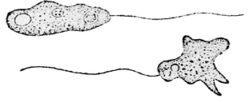Biology:Breviata
| Breviata | |
|---|---|

| |
| B. anathema | |
| Scientific classification | |
| Script error: No such module "Taxobox ranks".: | Breviatea |
| Script error: No such module "Taxobox ranks".: | Breviatida |
| Script error: No such module "Taxobox ranks".: | Breviatidae |
| Script error: No such module "Taxobox ranks".: | Breviata |
| Script error: No such module "Taxobox ranks".: | <div style="display:inline" class="script error: no such module "taxobox ranks".">B. anathema |
| Binomial name | |
| Breviata anathema Walker, Dacks & Embley 2006
| |
Breviata anathema is a single-celled flagellate amoeboid eukaryote, previously studied under the name Mastigamoeba invertens.[1] The cell lacks mitochondria, much like the pelobionts[2] to which the species was previously assigned,[1] but has remnant mitochondrial genes, and possesses an organelle believed to be a modified anaerobic mitochondrion, similar to the mitosomes and hydrogenosomes found in other eukaryotes that live in low-oxygen environments.[3]
Early molecular data placed Breviata in the Amoebozoa, but without obvious affinity to known amoebozoan groups.[3][4] More recently, phylogenomic analysis has shown that the class Breviatea is a sister group to the Opisthokonta and Apusomonadida. Together, these three groups form the clade Obazoa (the term Obazoa is based on an acronym of Opisthokonta, Breviatea, and Apusomonadida, plus ‘zóa’ (pertaining to ‘life’ in Greek)).[5]
References
- ↑ 1.0 1.1 "Ultrastructural Description of Breviata anathema, N. Gen., N. Sp., the Organism Previously Studied as "Mastigamoeba invertens"" (in en). The Journal of Eukaryotic Microbiology 53 (2): 65–78. 2006-02-10. doi:10.1111/j.1550-7408.2005.00087.x. ISSN 1550-7408. PMID 16579808.
- ↑ "Pelobionts are degenerate protists: insights from molecules and morphology" (Free full text). Molecular Biology and Evolution 19 (6): 978–82. 2002. doi:10.1093/oxfordjournals.molbev.a004157. ISSN 0737-4038. PMID 12032256. http://mbe.oxfordjournals.org/cgi/pmidlookup?view=long&pmid=12032256.
- ↑ 3.0 3.1 "Evolutionary position of breviate amoebae and the primary eukaryote divergence". Proceedings of the Royal Society B: Biological Sciences 276 (1657): 597–604. 2008-11-11. doi:10.1098/rspb.2008.1358. PMID 19004754.
- ↑ "Evolution: revisiting the root of the eukaryote tree". Current Biology 19 (4): R165–7. 2009-02-24. doi:10.1016/j.cub.2008.12.032. PMID 19243692.
- ↑ "Phylogenomics demonstrates that breviate flagellates are related to opisthokonts and apusomonads". Proceedings of the Royal Society B: Biological Sciences 280 (1769): 20131755. 2013-10-22. doi:10.1098/rspb.2013.1755. ISSN 1471-2954. PMID 23986111.
Wikidata ☰ Q4962544 entry
 |
